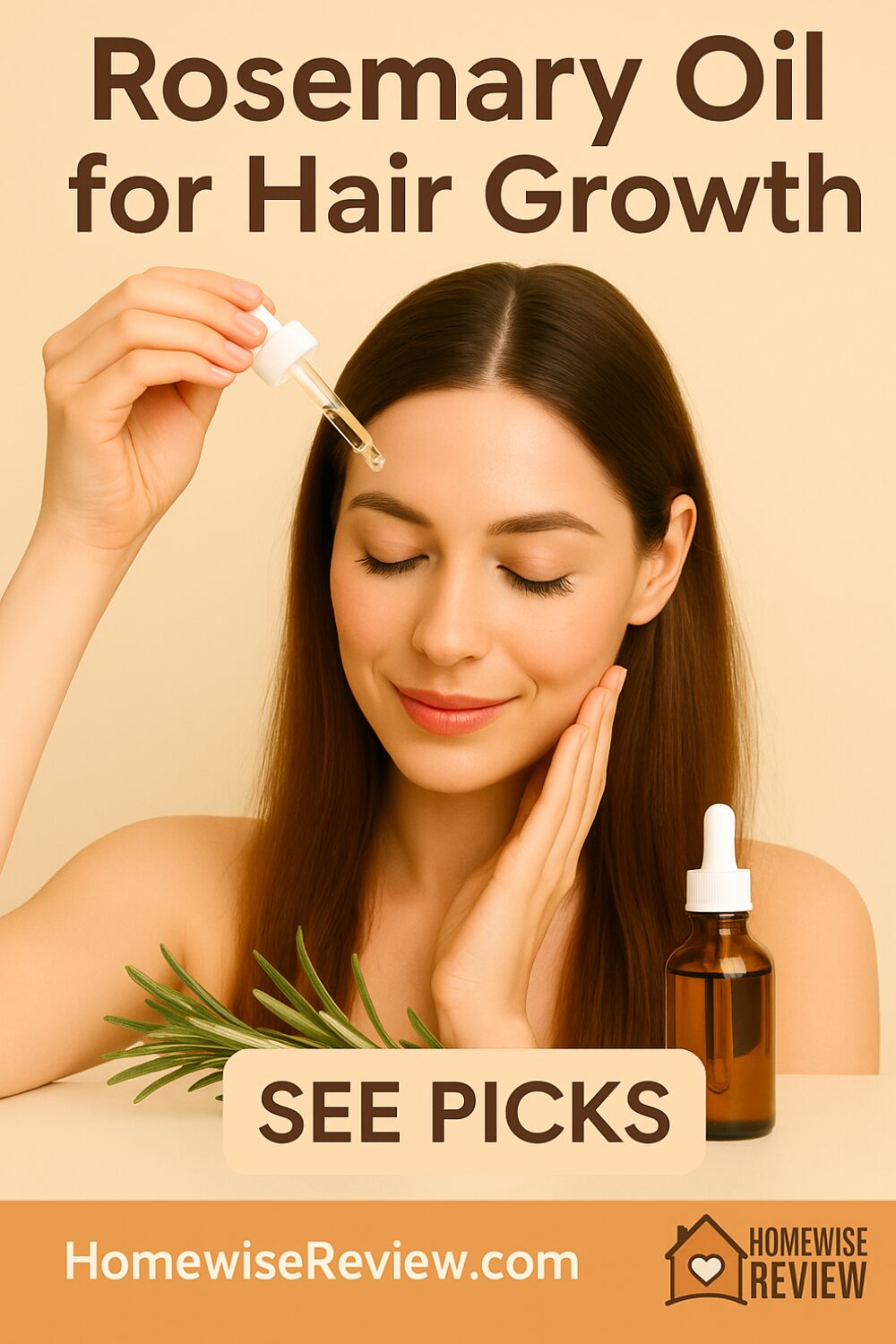
Looking for a growth booster that isn’t harsh or high-maintenance? Rosemary oil has become the buzzy botanical for fuller, healthier-looking hair. It’s loved for two big reasons: (1) it helps keep the scalp balanced (less buildup, better circulation), and (2) it supports stronger strands so you keep more of the hair you already have. A 2015 randomized trial even found 1% rosemary oil performed similarly to 2% minoxidil at the 6-month mark—while causing less itching. It’s not a miracle cure, but it’s a realistic, affordable helper you can fold into almost any routine.
This guide shows you the best rosemary formulas (pure oils and ready-to-use serums), exactly how to apply them for your hair type, what results to expect, and when to avoid rosemary altogether. Keep going for step-by-step directions, safety notes, and pro tips that make a real difference.
Quick Picks (4)
| Pick | Best for | Why it stands out | Notes |
|---|---|---|---|
| Mielle Rosemary Mint Scalp & Hair Strengthening Oil | Overall growth support + protective styles | Lightweight blend (rosemary, mint, biotin) with precision tip makes scalp application easy | Scented; use sparingly on fine hair |
| Cliganic Organic Rosemary Essential Oil (100% Pure) | DIY mixes | USDA-organic single-ingredient oil to dilute with your favorite carrier | Must dilute before scalp use |
| Sunny Isle Rosemary Mint Hair and Strong Roots Oil | Dry/coily hair, edges, protective styles | Rosemary + peppermint for stimulating, cooling scalp care in a lighter, faster-absorbing base | Patch test if sensitive to mint; lighter than classic JBCO |
Deep Dives (4)
1) Mielle Rosemary Mint Scalp & Hair Strengthening Oil
Rating: 4.7/5 (Ratings reflect a summary of owner feedback and stylist commentary.)
Why we like it: The pointed nozzle makes “between-row” application easy for protective styles or dense curls. The blend combines rosemary with mint, biotin, and botanicals that reduce breakage and improve slip at the ends.
Best for: Most hair types; especially textured hair and protective styles.
Feel/Scent: Lightweight oil with fresh herbal-mint scent.
Drawbacks: Fragrance/EOs may tingle; fine hair should use drops, not drench.
How to use: Trace your scalp in sections 3–4 nights a week; massage 2–3 minutes; wash as normal in the morning if you tend to get greasy.
2) Cliganic Organic Rosemary Essential Oil (100% Pure)
Rating: 4.7/5
Why we like it: Budget-friendly, USDA-organic, and perfect for custom dilutions (jojoba for normal, grapeseed for oily, pumpkin seed/castor for thinning edges).
Best for: DIY users, precise dilutions, mixing with other actives (e.g., caffeine, niacinamide watery serums on alternate nights).
Feel/Scent: Potent essential oil; must dilute.
Drawbacks: Requires measuring and patch testing.
How to use: Dilute to 1–3% (see recipe below) before scalp use.
Sunny Isle Rosemary Mint Hair & Strong Roots Oil
Rating: 4.6/5 (Ratings reflect a summary of owner feedback and stylist commentary.)
Why we like it
A lightweight take on growth-focused oils that combines rosemary (scalp stimulation) with peppermint (cooling, tingle) and Sunny Isle’s castor-oil know-how for better slip and spread. It’s excellent for scalp massages, protective styles, and refreshing the hairline/parts between wash days. Users consistently note calmer, less itchy scalps and healthier-looking edges with steady use.
Best for
All hair types seeking a lighter daily/3-4x weekly scalp oil; especially good for fine to medium textures that find traditional JBCO too heavy.
Feel & scent
Light-to-medium viscosity; absorbs faster than classic JBCO. Herbal-mint aroma with a clean, cooling sensation.
Drawbacks
The mint tingle can be too intense on very sensitive scalps—patch test first. If you prefer an ultra-heavy sealing oil, this may feel light.
How to use
Apply 3–6 drops directly to the scalp (nozzle tip helps), then massage 2–3 minutes. Use 3–4 times per week on clean scalp for best results. As a sealing oil, smooth 1–2 drops over damp ends after leave-in. If you experience buildup, schedule a gentle clarifying wash every 2–3 weeks.
How to Use Rosemary Oil (That Actually Works)
1) Choose your format
- Ready-to-use oils/serums (easiest): Use 3–5 nights/week on scalp.
- 100% essential oil: Always dilute before scalp use.
2) Smart dilution (DIY)
- Goal concentration: 1–2% for most; up to 3% if tolerated.
- How much is that?
- 1% ≈ 3 drops rosemary per 10 mL carrier oil
- 2% ≈ 6 drops per 10 mL
- 3% ≈ 9 drops per 10 mL
- Carrier picks:
- Fine/oily: grapeseed or squalane
- Normal: jojoba
- Dry/coily: jojoba + a little castor (70:30)
3) Application routine
- Part hair in 4–6 sections.
- Apply small drops directly to scalp (not just hair).
- Massage 2–3 minutes (pads of fingers).
- Leave on at least 2 hours—overnight is great.
- Shampoo as needed (every 1–2 days for oily; 2–3 days for dry textures).
4) Frequency & timeline
- 3–5 nights/week consistently.
- Expect reduced shedding ~8–12 weeks, visible fullness ~3–6 months.
- Take a monthly scalp/part photo under the same light—it’s the most honest progress tracker.
Who Sees the Most Benefit?
- Mild to moderate seasonal or postpartum shedding
- Early-stage thinning at the part/hairline
- Breakage-prone or protective-style wearers who need scalp care without harsh actives
- Oily or flaky scalps that improve with massage and gentle antimicrobial action
Manage expectations: Advanced genetic hair loss usually needs medical care (e.g., minoxidil, oral/topical Rx). Rosemary can be a supportive add-on, not a sole therapy.
Safety & Patch Testing
- Patch test: 24–48 hours behind ear or inner arm (use your final dilution).
- Avoid if pregnant/breastfeeding, epilepsy, or history of EO sensitivities (talk to your clinician first).
- Keep away from eyes; rinse with plenty of water if contact occurs.
- Essential oils are concentrated—more is not better.
Pro Tips by Hair Type
- Fine/oily: Use a 1% dilution in grapeseed or squalane; massage but rinse next morning.
- Curly/coily: Try 2% in jojoba + a touch of castor; focus on scalp, then glide leftover through ends.
- Protective styles: Nozzle bottle is your friend—trace parts lightly 2–3x/week.
- Sensitive scalp: Start 2–3 nights/week with a 1% dilution or try a ready-made low-fragrance serum.
See Also
If you’re targeting shedding and breakage from all angles, pair rosemary nights with a gentle wash routine. Our Best Clarifying Shampoos for Removing Buildup helps reset the scalp once a week, while Best Scalp Treatments for Dandruff covers calming options when flakes or itch kick up. For fragile ends, the picks in Best Protein Treatments for Damaged Hair and Best Conditioner for Damaged Hair reduce snap so the new growth you earn actually sticks around.
Styling matters, too. Keep heat gentle (or skip it) and protect what you’ve got with the top picks in Best Heat Protectant for Fine Hair, a good match for anyone using lightweight oils or serums. Together, these routines create the healthiest home for growth.
(Links to your posts: Best Clarifying Shampoos for Removing Buildup; Best Scalp Treatments for Dandruff; Best Protein Treatments for Damaged Hair; Best Conditioner for Damaged Hair; Best Heat Protectant for Fine Hair.)
FAQ
Does rosemary oil really regrow hair?
It can support healthier, fuller-looking hair—especially with consistent use over 3–6 months. Evidence suggests performance similar to 2% minoxidil at 6 months in one small trial, with fewer reports of itching.
Can I use rosemary oil with minoxidil?
Many people alternate (minoxidil AM, rosemary PM) or use rosemary on “off” nights. If you have a medical regimen, ask your dermatologist first.
Will it make my hair greasy or weigh it down?
Use a light carrier (grapeseed/squalane), stick to drops on the scalp, and shampoo as needed. Fine hair should avoid saturating lengths.
Can I use it on brows or beard?
Only with lower dilutions (≤1%) and after a patch test. Keep away from eyes.
What if I get irritation?
Stop, wash out, and switch to a gentler dilution or a ready-made low-EO serum. Persistent irritation = discontinue and consult a professional.
Bottom Line
Rosemary oil won’t replace medical treatments for significant genetic hair loss, but it’s a proven, low-lift way to improve scalp environment, reduce breakage, and support fuller-looking hair—if you use it consistently and correctly. Start with a low dilution, massage regularly, and track your progress monthly.




